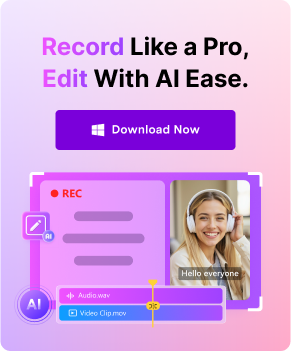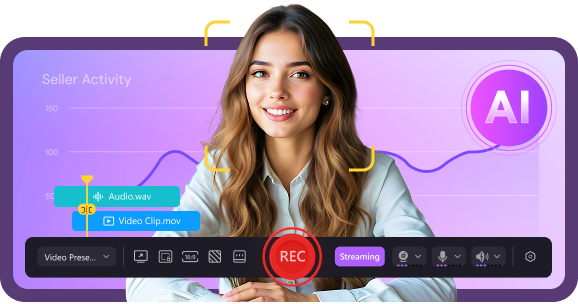In today’s world of video communication, virtual camera software has redefined how we connect and create. From professional work meetings to live streaming and content creation, these tools offer unmatched versatility and quality. Features like background effects, overlays, and seamless platform integration make virtual webcams essential for enhancing online interactions. Whether for casual calls or professional use, they ensure your video experience stands out.
In this article
Part 1: The Rise of Virtual Camera Software

With video communication becoming a cornerstone of modern interaction, virtual camera software has rapidly gained popularity. These tools enable users to go beyond the limitations of traditional webcams by offering advanced features like background effects, overlays, and seamless integration with popular platforms like Zoom and OBS Studio. Whether for work meetings, live streaming, or content creation, virtual webcams enhance the quality and creativity of video experiences.
Businesses rely on virtual webcam software to maintain a professional appearance during virtual conferences and webinars, while streamers and content creators use it to produce visually engaging content. The ability to replace or blur backgrounds, add custom branding, or incorporate dynamic effects has made these tools indispensable for elevating online interactions. As the demand for more personalized and high-quality video communication grows, the rise of virtual camera software for streaming highlights its importance in creating memorable, impactful digital experiences.
Part 2: What is Virtual Camera Software?
Virtual camera software, also known as virtual webcam software, is a tool that creates a virtual video feed, allowing users to customize and enhance their webcam footage in real-time. Unlike a standard physical webcam, which provides raw video input, virtual camera software acts as an intermediary, enabling users to add filters, overlays, animations, and other effects before transmitting the feed to platforms like Zoom, Microsoft Teams, or OBS Studio. This customization is achieved by modifying live video or incorporating media such as images and pre-recorded videos into the output.

Some common applications of virtual camera software include:
- Video conferencing: Enhance your video calls with virtual backgrounds, filters, and other effects to create a more engaging and professional experience.
- Streaming: Add creative overlays, animations, and transitions to your live streams to captivate your audience.
- Content creation: Use virtual camera software to create unique and visually appealing video content for social media, YouTube, or other platforms.
Part 3: Key Features of Virtual Webcam Software
Virtual webcam software is packed with features that transform the way users engage in video communication, live streaming, and content creation. These tools provide a wide range of customization options, allowing users to create professional and visually engaging video outputs.
Key Features:
- Background Effects: Virtual webcam software allows users to replace or blur their backgrounds seamlessly, eliminating distractions and enhancing professionalism. Whether you need a virtual office setup or a creative background for live streams, this feature ensures versatility without requiring a green screen.
- Overlays and Filters: Add text, images, animations, or fun filters to your video feed for a personalized touch. Overlays can be used for branding during business meetings or for adding dynamic elements to live streams.
- Multi-Source Input: These tools can combine multiple media sources, such as live video, images, and videos, into a single stream. This is particularly useful for presentations or content creators who want to incorporate various elements into their videos.
- Real-Time Adjustments: Virtual webcams enable users to edit their video feed in real-time, applying effects, adjusting settings, or switching between layouts during live sessions without interruptions.
- Platform Compatibility: Designed to integrate seamlessly with popular platforms like Zoom, Microsoft Teams, Skype, OBS Studio, and Twitch, virtual camera software ensures users can enhance their video experience across different applications.
- Advanced Customization Options: Many virtual webcams offer additional features like scene transitions, multi-camera support, and audio mixing, enabling more control over video and audio quality.
Part 4: Top 6 Virtual Webcam Software
Choosing the right virtual webcam software is essential for enhancing video quality, customizing backgrounds, and adding creative effects. Whether you're a professional, a content creator, or a streamer, these tools offer features that cater to diverse needs. Here are six popular options, each with unique capabilities to transform your video communication and streaming experiences.
1. Wondershare DemoCreator
Wondershare DemoCreator is a versatile and beginner-friendly virtual camera software designed for professionals and creators. It combines screen recording with advanced webcam effects, making it a powerful tool for video conferencing, tutorials, and content creation. With its real-time editing and easy-to-use interface, DemoCreator enhances both video quality and engagement. The software seamlessly integrates with platforms like Zoom, OBS Studio, and Teams, providing creative flexibility.

Features:
- Background Replacement: Replace or blur your background in real time to maintain a professional appearance during calls or recordings.
- Built-In Effects and Filters: Choose from a variety of effects and filters to add creativity and visual appeal to your videos.
- Screen Recording with Webcam Overlay: Record your screen and integrate your webcam feed simultaneously, perfect for tutorials or presentations.
- Post-Production Editing: Use advanced editing tools to refine and polish your videos after recording.
- Platform Integration: Easily works with major video conferencing and streaming platforms for seamless connectivity.
Ideal Use Cases:
- Creating educational tutorials and webinars.
- Enhancing professional virtual meetings.
- Recording engaging content for YouTube or social media.
Step-by-Step Guide to use Webcam Software
Step 1Launch DemoCreator and Choose Camera Mode
Launch Wondershare DemoCreator on your device to begin. From the main interface, click on the “Video Recorder” option. Within the video recorder settings, select the “Screen & Camera” option. This mode allows you to capture both your screen and webcam feed simultaneously, making it ideal for virtual meetings, presentations, or live streaming.
Also, you can do this online through DemoAir!

Step 2Customize Settings and Start Recording
Once in the Screen + Camera mode, configure your recording preferences to enhance your video feed. Adjust the screen recording area, resolution, frame rate, and audio input under the Preferences (Settings icon) menu. Enable the virtual background feature to replace or blur your background for a professional look. After setting everything up, click “REC” to start recording your screen and webcam feed.

Step 3Edit and Share Your Video
After recording, click on “Advanced Editing” to access the built-in editor. In this editor, you can refine your video by trimming, cutting, or applying effects. Use the tools from the left-hand menu, such as Templates, Annotations, Video Effects, Audio Effects, Cursor Effects, Pan & Zoom, and Transitions to enhance your video professionally. Once editing is complete, click “Export” to save your video in your preferred format and resolution. Use the final output as a virtual camera feed on platforms like Zoom, OBS Studio, or Teams, or share it directly on social media.


2. Snap Camera
Snap Camera brings a fun and interactive edge to virtual webcams, making it ideal for casual users and creative professionals. It allows users to apply Snapchat’s extensive library of filters to video calls, streams, and recordings. Easy to set up and compatible with platforms like Zoom and OBS Studio, Snap Camera transforms simple video interactions into visually engaging experiences.

Features:
- Extensive Filter Library: Access a wide range of Snapchat filters to personalize your video feed with fun and creative effects.
- Custom Filter Creation: Design and apply your own filters to match specific themes or events.
- Real-Time Application: Apply filters during live calls or streams without affecting performance.
- Lightweight Software: Runs efficiently without demanding high system resources, ensuring smooth operation.
- Platform Compatibility: Works seamlessly with popular tools like Zoom, OBS Studio, and Teams.
Ideal Use Cases:
- Adding a creative touch to social video calls.
- Making live streams more interactive and engaging.
- Using custom filters for themed virtual events.
3. OBS Studio
OBS Studio is a powerful, open-source virtual webcam software tailored for professional streamers and content creators. It offers high-quality video and audio capture, customizable effects, and multi-source input management. With its advanced features and plugin support, OBS Studio is a top choice for live streaming, event hosting, and video production.

Features:
- Multi-Source Input: Combine video feeds, images, and audio into one cohesive stream for a professional touch.
- Customizable Transitions: Create smooth scene transitions and effects to enhance your video’s production value.
- High-Quality Capture: Capture video and audio in real time with minimal latency for seamless streaming.
- Plugin Support: Extend functionality with third-party plugins to tailor the software to your needs.
- Cross-Platform Support: Compatible with Windows, macOS, and Linux, making it accessible to a wide audience.
Ideal Use Cases:
- Hosting live events or webinars with multi-camera setups.
- Streaming gameplay or professional content on Twitch or YouTube.
- Recording high-quality tutorials or product demonstrations.
4. Ecamm Network
Ecamm Network is a premium virtual webcam tool designed exclusively for Mac users. Known for its sleek interface and high-definition capabilities, it simplifies live streaming and video production. Ecamm offers robust features like multi-platform streaming, overlays, and customizable backgrounds, making it a go-to choice for professionals.

Features:
- HD Video Quality: Stream and record in high definition, ensuring a professional look for all video content.
- Customizable Overlays: Add text, logos, or graphics to personalize and brand your video feed.
- Multi-Streaming Support: Broadcast live to multiple platforms simultaneously, saving time and effort.
- Easy Integration: Works seamlessly with macOS tools and popular streaming platforms.
- User-Friendly Interface: Designed specifically for Mac users with an intuitive and easy-to-navigate layout.
Ideal Use Cases:
- Hosting branded webinars or virtual events.
- Creating high-quality marketing videos.
- Streaming live tutorials or classes on multiple platforms.
5. XSplit VCam
XSplit VCam is a cutting-edge virtual camera app known for its advanced background removal and blurring technology. It allows users to replace, remove, or blur backgrounds without the need for a green screen. This software is perfect for enhancing professional video calls, live streaming, or content creation.

Features:
- Background Removal: Eliminate your background entirely for a clean and distraction-free video feed.
- Background Blur: Add a soft blur to maintain focus on the subject while hiding clutter.
- Custom Background Replacement: Replace your background with an image or video to match your setting or theme.
- Seamless Integration: Compatible with major video conferencing and streaming platforms for easy use.
- Lightweight Performance: Runs efficiently on most systems, ensuring minimal lag or resource usage.
Ideal Use Cases:
- Enhancing professional video calls with custom backdrops.
- Live streaming with visually appealing effects.
- Branding during virtual presentations or meetings.
6. vMix
vMix is a powerful virtual camera software designed for professional live production and streaming. It offers features like multi-source mixing, real-time transitions, and 4K video support. Ideal for large-scale events, it provides advanced tools for dynamic video creation. vMix is a top choice for high-quality streaming and production needs.

Features:
- Multi-Source Mixing: Combine multiple video feeds, images, and audio sources for dynamic live production.
- Real-Time Effects: Apply transitions and effects during live streams for polished video output.
- 4K Streaming and Recording: Produce high-resolution content with support for 4K video.
- Advanced Input Management: Control multiple inputs with ease, ideal for complex setups.
- Hardware Compatibility: Works seamlessly with professional cameras and streaming equipment.
Ideal Use Cases:
- Managing live broadcasts for events or conferences.
- Producing professional-grade videos with multi-camera setups.
- Streaming 4K content for high-quality online engagement.
Part 5: How to Choose the Right Virtual Camera Software
Selecting the best virtual camera software requires evaluating your needs and matching them with the right features. From user-friendly interfaces to system performance, finding the right tool ensures a seamless video experience for both professional and creative purposes. Here are the key factors to consider:
- User Interface: Choose software with an intuitive and easy-to-navigate interface. This makes it easier to learn and use, especially if you are new to virtual webcams or not technically inclined.
- Features: Evaluate the features offered by each software. Determine which functionalities are essential, such as background replacement, green screen effects, filters, and overlays, to meet your specific needs.
- Compatibility: Ensure the software is compatible with your operating system (Windows, macOS, Linux) and integrates well with the platforms you use, such as Zoom, Google Meet, Twitch, or OBS Studio.
- Performance: Consider the system requirements and the impact on your computer's performance. Resource-intensive software may slow down systems with limited processing power.
- Price: Virtual camera software varies in cost, from free options to high-end professional tools. Select one that fits your budget while offering the best value and features for your needs.
Conclusion
Virtual camera software has transformed the way we connect, create, and engage in the digital world. With features like background effects, overlays, and seamless platform integration, these tools offer endless possibilities for enhancing video calls, streaming, and content creation. Among the many options, Wondershare DemoCreator stands out for its ease of use, advanced features, and seamless compatibility with popular platforms. Whether you're a professional, content creator, or casual user, DemoCreator empowers you to elevate your video experiences effortlessly. Explore its capabilities today and take your video communication to the next level.
FAQs
-
What is the difference between virtual camera software and a physical webcam?
A physical webcam provides raw video input directly from the camera to your device. In contrast, virtual camera software acts as an intermediary, allowing you to customize the video feed with filters, overlays, and effects before transmitting it. This adds creativity and professionalism to your video output.
-
Can I use virtual camera software with any video conferencing platform?
Yes, most virtual webcam software works seamlessly with popular platforms like Zoom, Google Meet, Microsoft Teams, and OBS Studio. Before downloading, ensure the software is compatible with your operating system and the platform you plan to use for smooth integration.
-
Do I need advanced technical skills to use virtual camera software?
No, many tools, including free virtual webcam options, are designed for ease of use. They feature intuitive interfaces with simple navigation, making them accessible to beginners and professionals alike, regardless of technical expertise.
-
What features does Wondershare DemoCreator offer for webcam recording?
Wondershare DemoCreator provides advanced features such as real-time background replacement, screen recording with webcam overlays, and built-in effects and filters. These tools help you create polished, professional-quality videos with minimal effort.
-
Will using virtual camera software affect my computer's performance?
Some virtual camera software may be resource-intensive, especially those with advanced features like 4K streaming. To ensure smooth performance, opt for lightweight options like virtual camera freeware or verify that your device meets the software’s system requirements.



